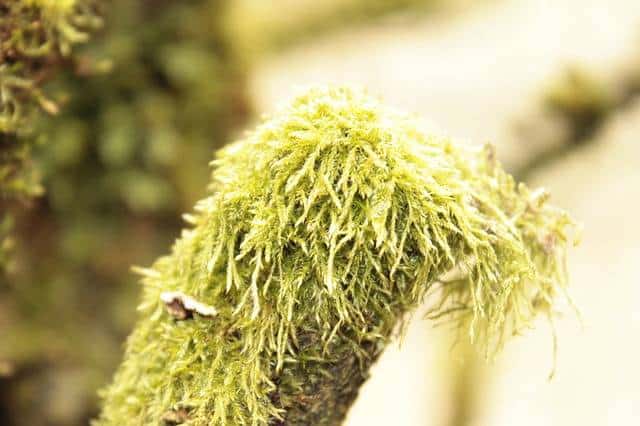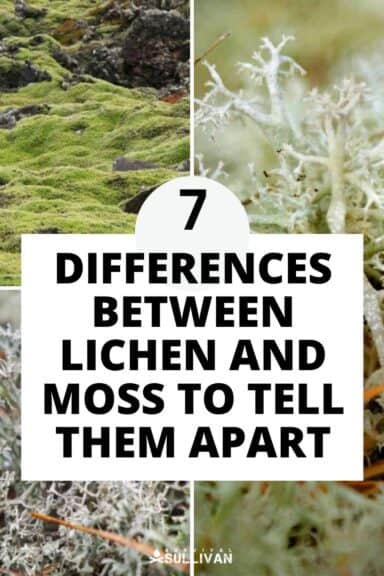Whenever you come across fluffy, strange growths on trees or fallen logs out in the wild, do you ever wonder if you’re looking at moss or lichen?

edible lichens collage
Both are low-growing, creeping organisms that are typically found in out-of-the-way places where there is little chemical contamination, but that’s where the similarities actually end…
Mosses are true plants, but lichens aren’t, even though many lichens have “moss” right in the name. Is this just plant facts for nerds? Hardly: telling the two apart can save your life in a wilderness survival scenario…
Mosses and lichens both have their own applications as survival resources, so it pays to avoid confusion. To stop you from getting mixed up when the chips are down, I’m bringing you a short guide with 7 differences between moss and lichen. We will get right into it below…
The Scientific Difference
For starters, you shouldn’t let the fact that lichens are often called “moss” confuse you: these organisms could not be more different, and lichens are not even considered “real plants”.
Looking at mosses first, these are small and flowerless primitive plants belonging to the Bryophyta division, taxonomically.
Unlike most plants you and I are familiar with, though, mosses are non-vascular, meaning they have no ability to transport moisture and other resources throughout their structures.
Instead, they absorb it directly into their tissues from the nearby environment. That said, if you get up close with moss, they are recognizably plants.
Lichens, on the other hand, are very different. They are a sort of composite organism, best described as a symbiosis of fungi that houses algae or cyanobacteria in a mutually beneficial relationship.
Lichens often look similar to plants, including mosses, but if you examine their structures closely, you’ll see that they don’t have true vegetation or leaves at all. So, in short, all mosses are plants but no lichens are plants, even those that have “moss” in the name!

Spanish moss
Moss is Typically Green, Lichen Comes in Many Colors
One of the easiest ways to start telling mosses and lichens apart is by color. The vast majority of mosses are green because they rely on photosynthesis to create their food.
Accordingly, they need chlorophyll to do that, and chlorophyll is green. That said, you’ll sometimes find moss in various colors including red, purple, or brown.
Lichens vary considerably in color, nearly all colors of the rainbow. It can be many shades of green but also pale gray, brown, tan, black, purple, yellow, red, and more.
Of note, lichen that’s moist or hydrated will usually appear green more often than not because of the presence of algae inside the fungal structures, which will sometimes become visible.
Moss Grows Lower and Has a Different Growth Habit
Another easy identifier is the height and habit of the growth in question. Moss is, with precious few exceptions, invariably a low-growing plant.
Moss often appears like a thin carpet or covering of felt or fuzz on a surface. Even when it is ready for reproduction, the taller stems seldom grow more than a couple of centimeters.
Lichens also tend to be generally low growing compared to other true plants, but is usually taller than moss. Lichen also has a lifted, scaly, or flaky appearance, or can sometimes look like thick clumps or mats of mold. It can also appear as a tangle of relatively long fibers or filaments, up to several inches tall, almost like a small shrub.
There are many varieties of lichen out there, and their fungal structures differ radically. Sometimes lichen can be almost indistinguishable from moss until you examine it up close or with a practiced eye. Other times it is unmistakable…
If you notice one of these growths and it is substantially taller than the underlying surface, chances are you’re dealing with lichen and not a true moss.
Moss Always Grows in Dark, Damp Places
Moss is a delicate, picky plant and will only grow in places that are free of contamination, that are dark or shady, and very moist at all times. Moss, if allowed to dry out, exposed to intense direct sunlight or high temperatures generally, will die back.
Lichens are Found in All Kinds of Environments
Lichens, depending on the variety, also have specific environmental requirements, but as an organism, are far more adapted and widely distributed compared to mosses. Lichens can survive almost anywhere, from the driest deserts to the most frigid polar reaches.
Deep forests, high mountains, volcanic slopes, urban environments, and even toxic wasteland: there is no environment on planet Earth where lichen hasn’t successfully thrived in. In fact, scientists speculate that about 7% of Earth’s surface is already covered in lichen!
If you are in a dry place, any place that gets intense sunlight throughout the day, or an area where there is chemical or atmospheric contamination, chances are you aren’t looking at moss.
Lichen Tends to Be Crusty, Crunchy or Slimy in Texture; Moss is Softer
Look closely at the texture of the growth in question, and touch it if you think it is safe: Moss is usually soft and springy. It will feel plant-like, and that’s because it is!
Lichen can take many shapes and forms, but as a general rule of thumb, it will feel crunchy, flaky, dry, and crumbly, or else it will be mushy and slimy. It might also collapse into a kind of powder or smear when touched.
Lichen, when deformed, typically won’t return to its original shape. You might say that it’s more brittle or fragile compared to moss, though both of these life forms are quite delicate when it comes to physical contact.
Take the time to familiarize yourself with different kinds of lichen, and you will see that its textures can run the gamut from slimy to dry and everything in between, but moss will always feel plant-like; like cool, soft, live leaves.
Moss Always Has Tiny But Visible Leaves and Stems- Lichens Don’t!
Speaking of leaves, if you care to break out your magnifying glass or if you just have a really good 20/20 vision, you’ll notice that moss will always, always have its distinct, visible, and discernible leaves and stems.
Very tiny ones, but they are definitely there! Again, this is because moss is true plant life and depends on these structures for food and, eventually, for reproduction.
Lichen, though, does not, even though many varieties like foliose lichens, wolf lichen, and others might appear leafy.
Get close and look carefully, and you can make out the individual fronds and anatomical structures of the leaves on moss whereas lichen, despite appearances, really has nothing whatsoever in common with leaves aside from a general shape or outline.
It doesn’t behave like a leafy plant, and in any case, those shapes are usually coincidental to how lichen interacts with its environment and tries to succeed.
A better way to say it is that varieties of true moss look very much like other plants you might already be familiar with, just in miniature. Lichens will only look leafy at first glance.

The post 7 Differences Between Lichen and Moss to Tell Them Apart appeared first on Survival Sullivan.
By: Tom Marlowe
Title: 7 Differences Between Lichen and Moss to Tell Them Apart
Sourced From: www.survivalsullivan.com/lichen-vs-moss-differences/
Published Date: Sun, 02 Jun 2024 18:18:42 +0000
------------------------
Did you miss our previous article...
https://bushcrafttips.com/bushcraft-news/21-different-paracord-keychain-designs-to-do-yourself
 What is BushcraftSurvival SkillsToolsVideosBushcraft CampsBushcraft KitsBushcraft ProjectsPrivacy PolicyTerms And Conditions
What is BushcraftSurvival SkillsToolsVideosBushcraft CampsBushcraft KitsBushcraft ProjectsPrivacy PolicyTerms And Conditions
